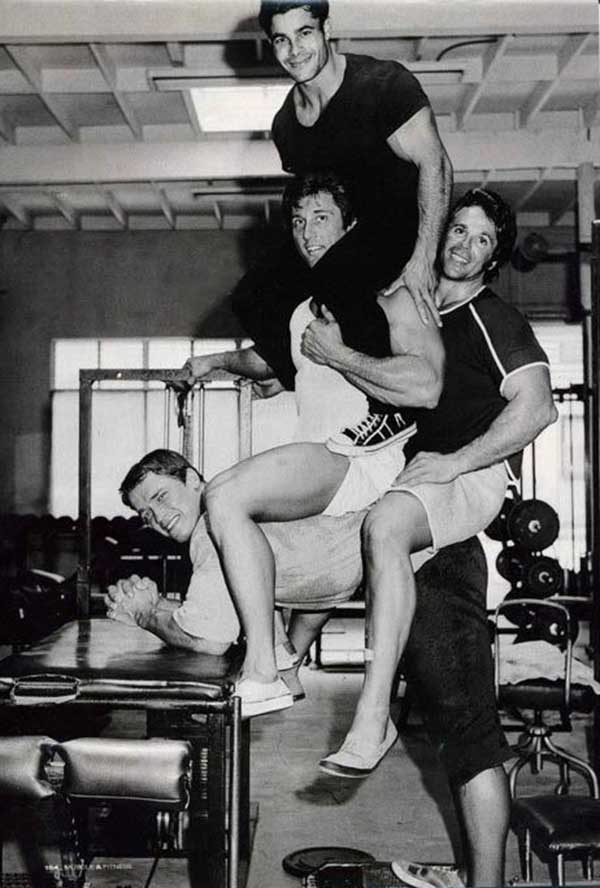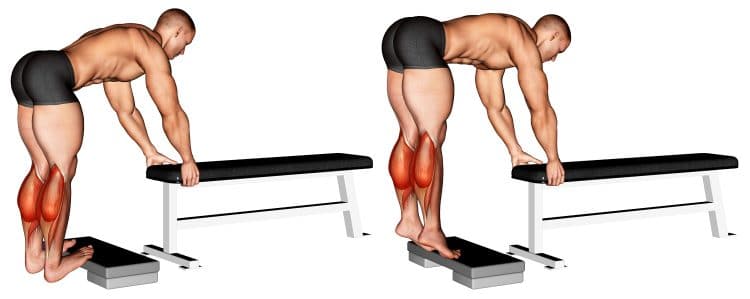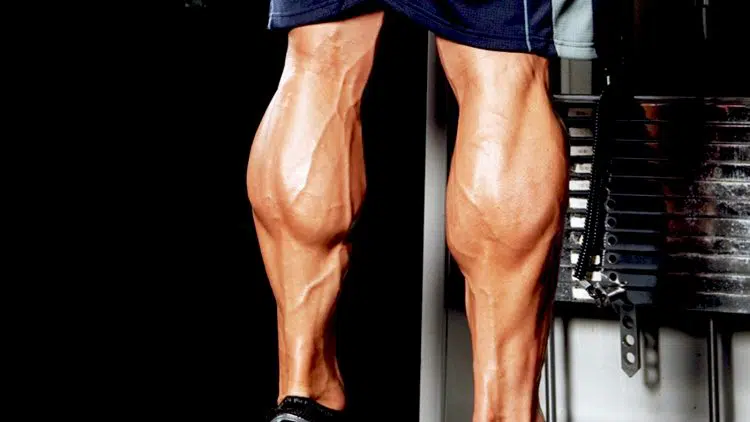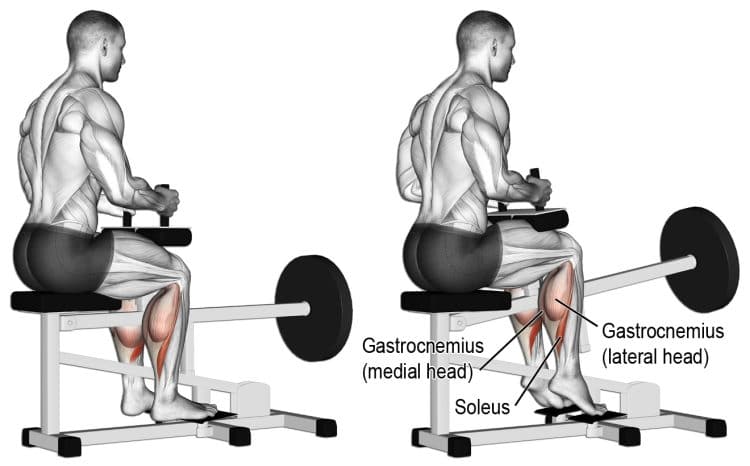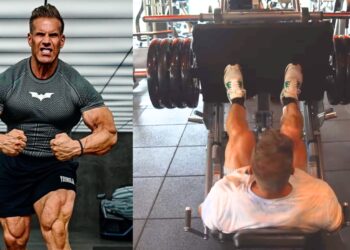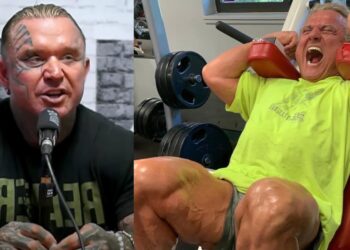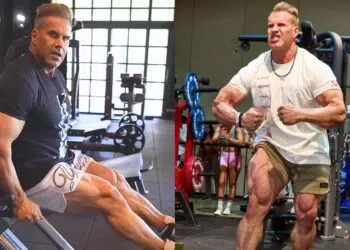Most gym-goers use machines to train their calves. Standing and seated calf raises are convenient and safe. These machines are also straightforward to use, and you can quickly adjust the weight, making them perfect for things like drop sets. Beginner, intermediate, and advanced lifters can all do seated and standing calf raises.
However, golden-era bodybuilders often had to make do with fewer machines. They needed to find other ways to develop muscular lower legs. One of the most popular exercises of the time was donkey calf raises, and this exercise is still sometimes used today.
The donkey calf raise is so-called because it involves leaning forward and supporting a training partner or two on your lower back. Hence, you look not unlike a beast of burden. While this exercise is an effective way to train the calves, it’s not without drawbacks.
For starters, you need a training partner of just the right body weight to make this exercise work. Also, that partner has to take care to sit astride your hips and not directly on your lower back, which could cause injury. And let’s be honest, this exercise looks unusual. You won’t see many people doing donkey calf raises, and if you include them in your workout, expect a few raised eyebrows and maybe a few giggles, too.
All of that said, donkey calf raises ARE an effective lower-leg workout, but they’re not suitable for everyone. In this article, we reveal the 12 best alternatives to this old-school calf exercise.
Level Up Your Fitness: Join our 💪 strong community in Fitness Volt Newsletter. Get daily inspiration, expert-backed workouts, nutrition tips, the latest in strength sports, and the support you need to reach your goals. Subscribe for free!
Donkey Calf Raise Anatomy
For any exercises to be considered an alternative to donkey calf raises, it needs to target the same muscles, albeit sing different training apparatus or a different movement.
The muscles developed by donkey calf raises are:
Gastrocnemius: This is the largest of the two calf muscles. It is a biarticular muscle which means it crosses two joints. Because of this, the gastrocnemius has two functions – ankle plantar flexion (pointing your toe) and knee flexion. The primary muscle responsible for knee flexion is your hamstrings, but gastrocnemius provides assistance.
Soleus: The soleus muscle is your lower, smaller calf muscle. It lies beneath and below your gastrocnemius. Soleus only crosses your ankle joint, and its function is also plantarflexion.
Gastrocnemius and soleus have different origin points but share the same insertion. They come together at your Achilles’ tendon, which attaches onto your heal bone, properly called your calcaneus. Despite this shared anatomy, it is possible to emphasize one muscle more than the other.
Plantarflexing your ankle with your knee straight, such as when doing donkey calf raises, focuses on your gastrocnemius. But, when you bend your knee, the soleus becomes more active. Because of this, most exercisers need to do both standing and seated calf raises.
12 Best Donkey Calf Raise Alternatives / Substitutes
There is no denying that donkey calf raises are effective. After all, they were a staple of old-school bodybuilders, and some of those guys had incredible lower leg development. That said, to do donkey calf raises, you need a willing training partner to sit across your hips or a donkey calf raise machine. This means donkey calf raises are not always practical and could even hurt your lower back.
The good news is that there are plenty of exercises you can do instead of donkey calf raises.
1. Smith machine donkey calf raise
Some gyms have dedicated donkey calf raise machines. However, such machines are pretty rare. You can replicate this exercise by using a Smith machine. Be warned, this is not an especially comfortable option, and you’ll definitely need to pad the bar to make it tolerable.
How to do it:
- Place a bench near a Smith machine. Below the bar, put a raised platform, such as a piece of 2×4 or a step box top, or a couple of stacked weight plates. Duck under the Smith machine bar, put your hands on the bench, and stand with the balls of your feet on the raised platform, heels hanging off the edge so they can more freely.
- Brace your core and press the bottom of your lower back against the bar. Put a folded exercise mat beneath the bar for comfort.
- With your legs straight, rise up onto your tiptoes, and then lower your heels down toward the floor to stretch your calves.
- Repeat for the desired number of repetitions.
2. Machine standing calf raise
Machine standing calf raises are one of the most popular lower leg exercises in most gyms. They allow you to go hard and heavy, which is crucial if you want to build bigger, more muscular lower legs.
If your gym doesn’t have a standing calf raise machine, you can also do this exercise using a Smith machine. Get the most from this exercise by pausing at the top and the bottom of each rep.
Learn how to do machine standing calf raises here.
3. Standing dumbbell calf raise
You don’t need a lot of equipment to train your calves. In fact, you can get a decent lower leg workout using nothing but a pair of dumbbells. Before you write this exercise off as being too easy, try doing a few high-rep sets with just 30 seconds rest in between.
Your calves will soon start to pump and burn. This is a good option for home exercisers and makes a great finisher to your lower leg workouts.
How to do it:
- Hold a dumbbell in each hand. Stand with your feet about hip-width apart. Brace your abs, pull your shoulders down and back, and look straight ahead.
- Rise up onto your tiptoes and hold this peak contraction for 1-2 seconds.
- Lower your heels back down to the floor and repeat.
4. Single leg dumbbell calf raise
Working one leg at a time is a good way to fix left to right strength imbalances. It also puts more weight through your calves, which may be helpful if you need additional overload.
Single leg dumbbell calf raises require greater ankle stability than the two-legged version, which increases calf engagement. All in all, this is a good low-tech but high-effect calf builder.
Learn more about single calf dumbbell calf raises here.
Level Up Your Fitness: Join our 💪 strong community in Fitness Volt Newsletter. Get daily inspiration, expert-backed workouts, nutrition tips, the latest in strength sports, and the support you need to reach your goals. Subscribe for free!
5. Machine seated calf raises
Seated calf raises emphasize your soleus, which is your smaller, lower calf muscle. While this muscle is trained during standing and donkey calf raises, doing them seated means you can really focus on your soleus.
Find out how to do machine seated calf raises here.
6. Barbell seated calf raise
Machines make calf training easy. Just select the weight, hop on, and get to work! But what if you work out at home or your gym doesn’t have an extensive range of machines? The good news is that you can replicate machine seated calf raises using nothing more than a barbell and a bench.
How to do it:
- Sit on an exercise bench, so your shins are vertical. Place the balls of your feet on a low platform, such as a length of 2×4 or a couple of stacked weight plates. Rest a barbell across your lower thighs, just above your knees. Pad it with a folded exercise mat if necessary.
- Rise up onto your tiptoes and hold this peak contraction for 1-2 seconds.
- Lower your heels down, stretch your calves, and repeat.
- You can also do this by resting and holding a dumbbell on each leg.
7. Tiptoe farmer’s walk
Have you ever noticed how a lot of overweight people have HUGE calves? It seems that walking around with a lot of weight on your calves could make them grow. This exercise is designed to simulate this effect. Tiptoe farmer’s walks are also good for ankle stability and strengthening your feet.
How to do it:
- Hold a heavy dumbbell or kettlebell in each hand. Use straps if you need to reinforce your grip.
- Rise up onto your tiptoes.
- Without lowering your heels, walk around your training area until your calves are pumped and burning.
- You can also do this exercise with a barbell across your upper back.
8. Explosive calf raise
Most donkey calf raises are done using a slow and deliberate tempo. This helps increase time under tension (TUT) which is important for hypertrophy. However, if you want to shake up your calf training and stimulate new growth, lifting more explosively may help.
This novel exercise increases calf muscle fiber recruitment. It is also good for improving muscle power for better running and jumping performance.
How to do it:
- Position yourself on a standing calf raise machine or Smith machine (with plates to elevate the feet) so that your knees are slightly bent. Brace your core.
- Keeping your torso straight, explode upward using your quads, and forcefully point your toes.
- With your legs straight, slowly lower your heels down to get a good stretch, and then repeat.
9. Leg press machine calf raises
Leg press machine calf raises feel a lot like donkey calf raises as you do them with your hips flexed to 90-degrees and your knees straight. They also allow you to lift heavy weights in comparative safety. Do this exercise using two legs or one leg as preferred.
How to do it:
- On a loaded leg press machine, push the footplate up and then carefully position the balls of your feet on the lowermost edge.
- Keeping your legs straight, dorsiflex your ankles to lower the weight, and then push it back up.
- Take care not to let the balls of your feet slip off the footplate. That would result in a catastrophic injury.
10. Hack squat calf raise
Doing calf raises on a hack squat machine may seem a little convoluted or unnecessary. But, when it comes to building muscular lower legs, even small positional changes can unlock new muscle growth (1). Hack squat calf raises are different enough from standing calf raises that they could be just what you need to increase calf size.
How to do it:
- Face the backrest of your hack squat machine. Place your shoulders beneath the pads and the balls of your feet on the edge of the footrest. Straighten your legs and lift the weight.
- Keeping your core tight and your knees straight, push up onto your tiptoes, and then lower your heels down as far as you can.
- Keep going until you have completed all the prescribed reps.
11. Ankle jumps and hops
Athletes who do a lot of sprinting and jumping often have larger than average calves. Explosive extension of the ankle joint increases gastrocnemius and soleus engagement, targeting the fast-twitch type 2b muscle fibers, which have the greatest potential for size and strength.
This exercise provides your lower legs with an effective plyometric workout and is an excellent way to finish your regular calf training program.
How to do it:
- Stand with your feet together and your hands by your side.
- Keeping your knees as straight as possible, jump up and down on the spot by pushing off your toes. Do not let your heels touch down.
- Continue for the prescribed number of reps.
- Jump from side to side to work the lateral (side) aspect of your calves.
- Too easy? Hop on one leg or hold dumbbells in your hands.
12. Steep uphill walking and running
Walking and running uphill are very effective fat burning and conditioning exercises, but they’re good for calf growth too. The steeper the hill, the harder you’ll need to push off your toes, and the more work your calves will have to do. Make uphill walking and running even more calf-centric by staying on your toes and keeping your heels off the floor.
Take care; steep inclines put a lot of pressure on your Achille’s tendon. If injured, this tendon can take a long time to heal. Avoid injury by warming up thoroughly and stretching your calves after your workout. Increase the duration and intensity of your workouts gradually.
How to do it:
- Find a steep hill and walk or run up it, making sure you push off your toes during each step.
- Carry dumbbells or wear a weighted vest or backpack to make your workout more demanding.
- You can also do this exercise using stairs instead of a hill. Again, make sure you push off your toes or stay on tiptoes to maximize calf engagement. Walking or running uphill on a treadmill is another way to train your calves.
More Leg & Calf Exercises:
- 15 Ways To Turn Your Calves Into Full Grown Bulls
- 9 Best Calves Exercises
- Machine Seated Calf Raise
- Machine Standing Calf Raise
- Machine Seated One-Leg Calf Raise
- Standing Dumbbell One-Leg
More Alternative Exercises:
- Best Calf Raise Machine Alternatives
- Bulgarian Split Squat Alternatives
- Hanging Leg Raise Alternatives
- Leg Extension Alternatives
- Best Leg Curl Alternatives
- Best Hack Squat Alternative
- Best Box Jump Alternatives
- Best Alternatives to Lunges for Bad Knees
- Romanian Deadlift Alternatives
- Leg Extension Alternatives
- Leg Curl Alternatives
Wrapping Up
A lot of people are quick to blame their lack of calf growth on poor genetics. While there is no denying that genetics can affect muscular development, a lot of these so-called hard gainers are simply not training their calves hard enough.
The calves are strong, resilient muscles. They can take a pounding and recover quickly. If you are just doing 3-4 sets of calf raises once a week, it’s shouldn’t be a surprise that they aren’t growing.
If you want more muscular lower legs, it’s time to make them a priority, rather than treating them as an afterthought. Do 2-4 exercises per workout and train your calves twice a week. Use the same training methods you use for the rest of your body, i.e., training to failure, drop-sets, paused reps, and whatever other workout intensifiers you normally use to bring up a lagging body part.
Above all, start hitting your calves from multiple angles. Use donkey calf raises if you like or any of these 12 alternatives. With some time and plenty of effort, you’ll turn your little calves into massive cows!
References:
1 – PubMed: The Effects of Exercise Variation in Muscle Thickness, Maximal Strength and Motivation in Resistance Trained Men https://www.ncbi.nlm.nih.gov/pmc/articles/PMC6934277/
Interested in measuring your progress? Check out our strength standards for Seated Calf Raise, Bulgarian Split Squat, Machine Calf Raise, and more.

